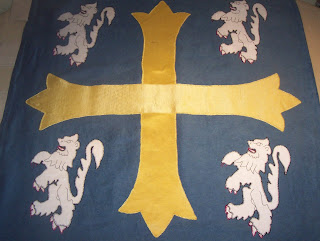Why am I telling you about it - not just because I love the prog
 ramme but also I am going to be in it! Not sure which of the 3 episodes it will be, but I was invited along to dye ribbons in natural dyes for the Christmas decorations and presents.
ramme but also I am going to be in it! Not sure which of the 3 episodes it will be, but I was invited along to dye ribbons in natural dyes for the Christmas decorations and presents.Here's Ruth and I during the filming, I actually really enjoyed it - I hate having cameras round me, can even be funny about having my photo taken, but Ruth was so good at leading and the crew were fabulous to work with.
The filming was back in June and I did mention in my blog then that I had been to Shropshire. What I would really like to express is my thanks to the Society of Dyers and Colourists for lending us the original sample of Mauvein that they have in their display at Perkin House, Bradford. You can see the wooden box in this picture - it is the original box that was posted by

William Perkin and still carries the stamp and post mark on the side. The yarns inside are silk and cotton. The colour is absolutely stunning, I may not want to work with the synthetic colours - but it is very obvious why they caused such a stir when you see them close up like this!
We had hoped to try out some new fangled chemical dyes as well as the natural dyes during the filming, but time did really run away with us, so I would like to express my thanks to Kemtex as well for supplying us with some samples to try. Everyone I approached was r
 eally helpful.
eally helpful.We used cochineal, weld and indigo in the ribbon dyeing. Ruth was made to work and I supervised, the colours we achieved I think you will agree are pretty fine!
Ribbon dyeing workshops are one of my favorites to run particularly round the November/December time as you can really personalize your Christmas presents with them. All done for this year - but there's always 2010!




























 The blue is indigotin - obviously! I had blue nails for a couple of weeks after this dyeing - to get the cloth even I had to move the fabric under the surface almost continuously and I couldn't use rubber gloves! I had tried to get the blue darker, but after 4 dips I really didn't think my hands could take anymore!
The blue is indigotin - obviously! I had blue nails for a couple of weeks after this dyeing - to get the cloth even I had to move the fabric under the surface almost continuously and I couldn't use rubber gloves! I had tried to get the blue darker, but after 4 dips I really didn't think my hands could take anymore! n the Huntley first (the boars heads seemed an easier option than the lions to break myself in!!) I've enlarged the boars head to a useable size and I needed 6, 3 each side . The paper was used as a template to cut round for the cloth and then I blanket stitched all round the edges before attaching them to the background pieces. The two sides were joined together and the hanging loops put in.
n the Huntley first (the boars heads seemed an easier option than the lions to break myself in!!) I've enlarged the boars head to a useable size and I needed 6, 3 each side . The paper was used as a template to cut round for the cloth and then I blanket stitched all round the edges before attaching them to the background pieces. The two sides were joined together and the hanging loops put in. 

















